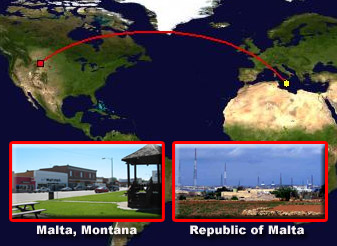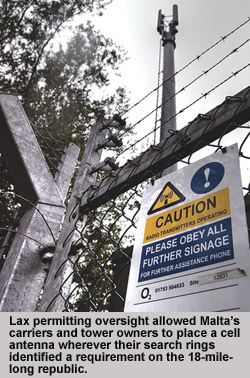Two Maltas, but one holds the world's record
with 2,111 more cell sites
March 27, 2009 - A total of 2,100 rural residents in Malta, Mt. receive mobile service through three cell tower sites. You'll also find an omni antenna in the center of town sitting atop an aging wooden pole, slightly off plumb, next to the Amtrak station bordering the downtown park. bordering the downtown park.
Otherwise, the view in big sky country is unfettered with communications towers, and residents appear to enjoy sufficient mobile coverage to call their neighbors and tell them about a recent discovery of a flock of pelicans, piping plovers or black footed ferrets in a nearby wildlife refuge.
Turn east at Route 2, continue northeast and southeast for another 5,785 miles and you will end up on a small rock set in the southern Mediterranean between Sicily and North Africa, only 18 miles long, with a population of 410,000.
It's the Republic of Malta and it appears to hold the distinction of having more cell sites per resident than any other country in the world, one for every 194 Maltese citizens.
Malta's high concentration of cell sites, totaling 2,114, eclipses the UK where its 61 million population and 47,000 sites provides one for every 1,297 people.
America fares slightly better than the UK. With 304 million residents, based upon CTIA-The Wireless Association's 2008 estimate of cell sites of 240,000, the ratio is one site for every 1,266 inhabitants.
Republic is now suffering from slack planning rules
The proliferation of cell sites were built in the wake of slack planning rules for their installation. Malta's mismanagement highlights how America's build-outs benefited from responsible siting.
In April 2007, a ruling allowed Malta's antennas to be installed without any planning notification, as long as the site was not located in a specified zone.
Most of their applications do not require a full planning permit or a development notification order.
During the past four years, the Malta Environment Planning Authority has only issued 49 DNOs and 104 full development permits for cell sites, and rejected just five DNOs and two notifications.
With his city awash with antennas, a Malta mayor has filed a judicial protest against Melita plc and the Malta Communications Authority, calling for the removal of a cell site on the roof of a residential home.
The antenna, which faces neighbors' bedrooms, is so close that a resident "can nearly touch the antenna from his own bedroom window," said Lija Mayor Castaldi Paris. nearly touch the antenna from his own bedroom window," said Lija Mayor Castaldi Paris.
The Archdiocese of Malta has entered into agreements with the three local carriers to install 43 antennas on its property since 2000. One of the most recent cell sites is an antenna installed on the Safi parish priest's house in the village square.
In addition to visual blight, many residents are concerned about health effects that they believe are causing more and more people to be diagnosed with cancer from antennas.
Radiation levels in Malta must conform to those set by the International Commission for Non-Ionizing Radiation Protection. According to the ICNIRP, radiation from cell site antennas only becomes harmful when it begins to heat tissues. That happens, ICNIRP claims, when levels surpass 450 Mhz; anything below that level they say is fine.
In response to concerns about radiation, Vodafone Malta said, "Mobile phones have been with us for 20 years. The majority of experts who study mobile phones, masts and health have suggested no changes to their current behavior when it comes to people using mobile phones or living and working in the area close to base stations."
The Malta Communication Authority's website contains readings of electromagnetic radiation taken from 411 cell sites located in nearly every town and village. The results to date show that radiation levels in all base stations not only fall within the ICNIRP's limits, but in most cases are at the lower levels.
Planners in the US cannot deny an application based upon perceived health effects, but a number of recent applications in Malta have been denied, due to the antenna's proximity to residences and schools and the possibility of furthering cancer clusters, a claim that is in conflict with the World Health Organization.
If you eavesdrop carefully in Malta, Mt. you might be able to listen to a pair of bull elk sparring in a ponderosa pine grove. In Malta, you're most likely to hear a loud alarm about the unplanned growth of cell site antennas.
|